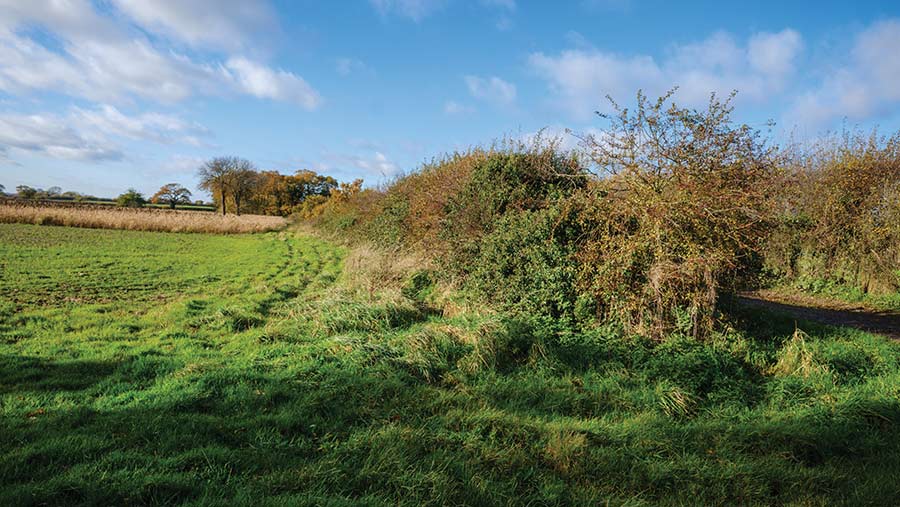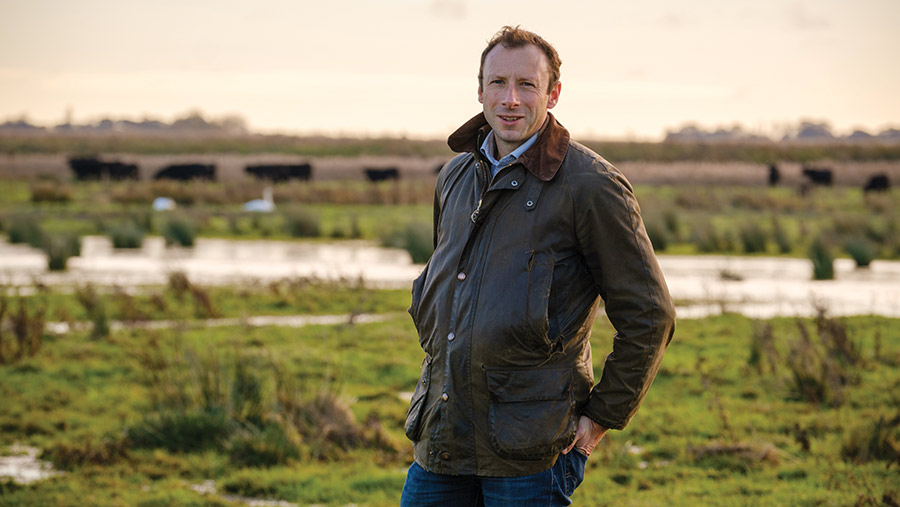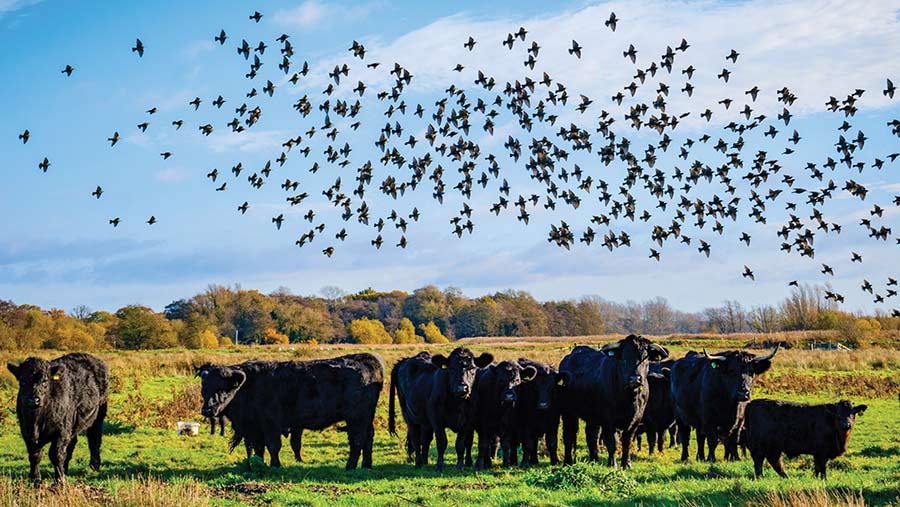Food production remains key on nature-friendly Suffolk arable farm
 © Jason Bye
© Jason Bye All three of the distinct land types at Somerleyton Estate, near Lowestoft, are being put to best use, generating a diversified income for the business and supporting both people and wildlife.
There is ample space and provision for nature following radical changes made five years ago.
As a result, almost 25% of the estate is managed in a different way, rather than being taken out of production, to help restore and enhance its environmental delivery.
See also: How to build a Johnson-Su bioreactor to produce your own on-farm biology
A new Higher Tier Countryside Stewardship scheme means some 1,500ha of productive arable land is interspersed with numerous options.
A 405ha nationally significant marshland is being managed to support wading birds, and rewilding is in place on another 400ha of very light, drought-prone land, where it complements tourism and boosts biodiversity.
The upshot is that every parcel of land works for food, conservation or the wider society, or a combination of all three, explains farm director Rob Raven, who stresses that food production works alongside biodiversity and the environment.
“That’s a really important point,” he says. “We haven’t sacrificed production for nature – we’ve just made sure that the land is being used appropriately and that the farmed environment is also contributing to habitat provision.”

Rob Raven © Jason Bye
Boosting soil health
The estate’s regenerative farming system is building soil health, reducing costs and minimising emissions.
It also allows livestock to play an important role as an integral part of the arable rotation, as well as providing grazing management on parkland and rewilded, rougher areas.
Cropping has been altered to build in resilience.
Sugar beet has been replaced by peas, the potato area has been scaled back and switched to early-lifting salad varieties, while winter and spring combinable crops have been chosen for their added value and local market appeal.
Multispecies cover crops are grown ahead of spring barley and peas, protecting the soil and cycling nutrients, as well as providing winter grazing for livestock – which are kept outside all year.
With winter wheat, malting barley, peas, oilseed rape, potatoes, winter beans and herbal leys, the rotation remains flexible to allow the business to react to market and weather conditions.
Direct drilling is used wherever possible and a muck-for-straw deal with a neighbour means soil organic matter content is up and fertiliser use is down.
Over time, pesticide and fuel use has come right down, soils are functioning well and wildlife is thriving – with the estate keeping records of different species and monitoring results.
Food marketing
Rob Raven has invested time to find local markets for the farm’s output, as the policy is to avoid growing feed crops.
As a result, the farm’s Maris Otter barley goes to a local maltster, combining peas are used to create a carbon-neutral vodka called Podpea, other pulses go to local business Hodmedod’s, and even the wheat is malted and sold as a specialist bakery ingredient.
Cattle sales are done through the Suffolk butcher network, while a contract with Waitrose sees September-born Dorset lambs fattened over winter on cover crops and supplied to the retailer in February, when British lamb is in short supply.
Rob is keen to generate more direct sales and form supply chain partnerships, but he is also wary of giving away or undervaluing the farm’s environmental credentials.
“Five years in, we know that the system is working and we have the results to prove it,” he says. “We now need to make sure we are being adequately rewarded for it.”
Marshland management
About 400ha of marshes are being managed sensitively to ensure water levels are high enough to support wading birds.
Adjacent to the River Waveney, the marshes have benefited from works to put in scrapes and install water gates and sluices, while pump control has allowed the estate team to manipulate water levels and bring water onto the grass.
“We deliberately keep it really wet over the winter,” explains Rob. “That way the wading birds stay here to breed and the chicks then have the mud and water edge environment they need in May.
“Once they have fledged, the marsh is drained.”
Welsh Black cattle graze the marsh in spring, summer and autumn, keeping the sward height in check, which helps to minimise predation. The cattle come off in the winter, when it is very wet, and are moved to the cover crops.

© Jason Bye
“Species such as lapwing, redshank and snipe are all thriving with this management,” he adds. “It also means we are generating income from meat sales and stewardship measures on this area.”
A further benefit is that neighbouring Suffolk Wildlife Trust and Raveningham Estate land is being managed similarly, providing a joined-up habitat at scale for wading bird populations.
Rewilding
A two-mile long lake at Somerleyton is surrounded by 400ha of heathland, some of the least productive and most drought-prone ground on the estate.
As a tourism business operates at one end of Fritton Lake, where 120 log cabins and leisure facilities have been established in a private holiday club, the natural environment is an attraction and feature of the site.
An on-site restaurant also provides an outlet for some of the estate’s meat.
The decision to rewild the surrounding land was taken by Lord Somerleyton, in line with the estate’s ethos and his commitment to WildEast (see “Nature charity”).
Surrounded by a 10km fence, Highland cattle, Exmoor ponies and Large Black pigs are used to manage the area naturally, with livestock numbers vital to success.
Apart from grazing, the only other management is some bracken control, reveals Rob Raven, which is done by topping or rolling.
“Thorn and scrub is starting to creep in from the edges,” he says. “We are also seeing certain plant and bird species starting to come back. It’s a wonderful area for wildlife and it gives the tourism enterprise extra appeal.”
The historic parkland around Somerleyton Hall has a slightly different rewilding approach.
A permanent herd of Welsh Black cattle and some Exmoor ponies are used to manage the grass and allowed to exhibit natural behaviour, with careful attention paid to prevent overgrazing.
The resulting tussocky grass is proving to be a very good habitat for small mammals and a good hunting ground for owls and other predators.
Nature charity
Hugh Somerleyton is one of the three founders of WildEast, a charity intent on making space for nature in East Anglia and reversing the declines seen in recent years.
Its ambition – to return 250,000ha of land to nature – is targeted at farms, businesses, schools and other industries in the region, with everyone being encouraged to leave a bit of land to “do its own thing”. See the WildEast website for more information.

